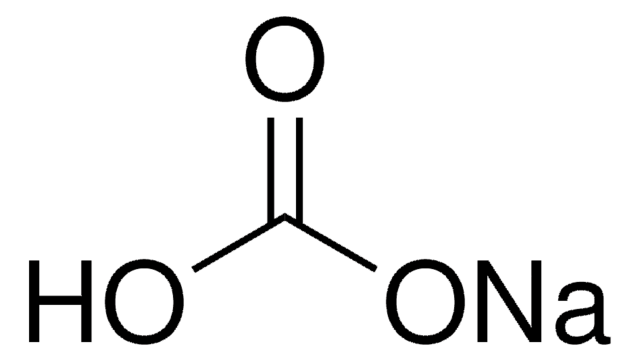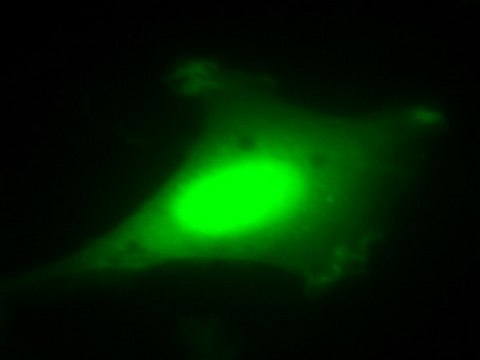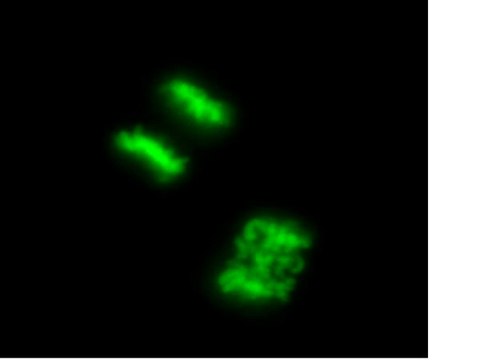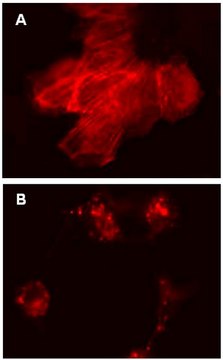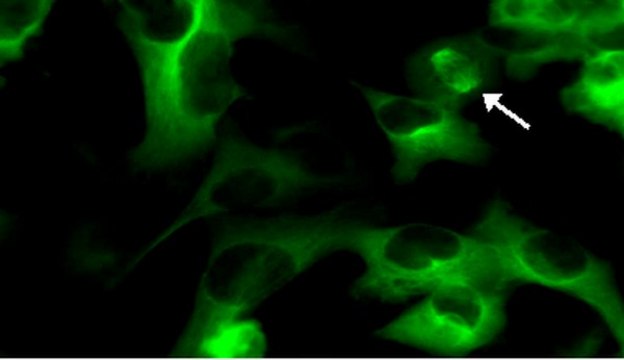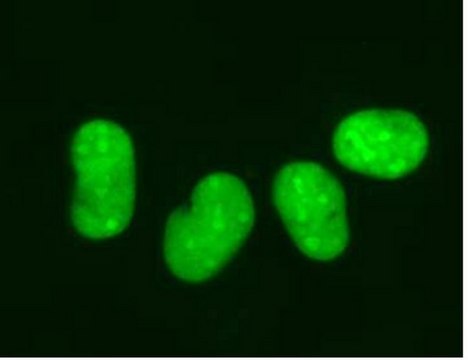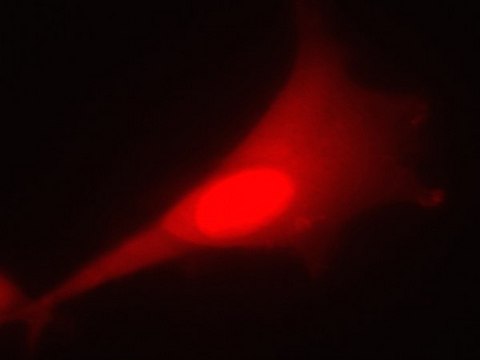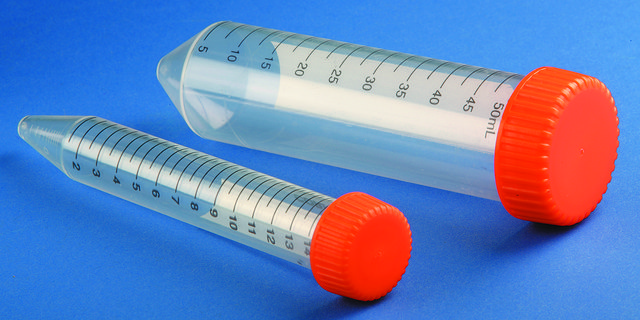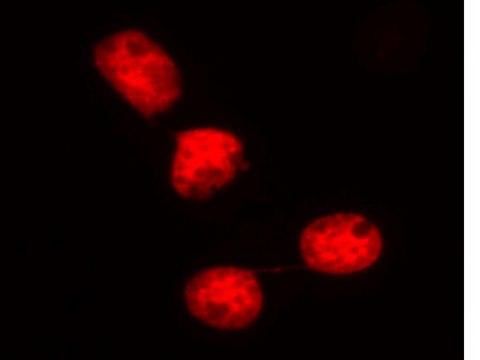推荐产品
一般描述
Actin is a highly abundant globular protein found in the cytosol of all eukaryotic cells that assembles in a head-to-tail arrangement to form double helical, polarized microfilaments. Actin microfilaments constitute one of the 3 major cytoskeletal structures, and they participate in many important cellular processes including muscle contraction, cell motility, cytokinesis, vesicle and organelle movement, cell signaling, the establishment and maintenance of cell junctions and cell shape. In vertebrates, three main groups of actin isoforms, alpha, beta, and gamma, have been identified; in most cell types, β-actin is the primary component of the cytoskeleton. Fusions of fluorescent proteins to β-actin have proven very useful tools in elucidating the dynamics of actin microfilaments in many cellular processes.
EMD Millipore’s LentiBrite GFP-β-actin lentiviral particles provide bright fluorescence and precise localization to enable live cell analysis of actin microfilament dynamics in difficult-to-transfect cell types.
EMD Millipore’s LentiBrite GFP-β-actin lentiviral particles provide bright fluorescence and precise localization to enable live cell analysis of actin microfilament dynamics in difficult-to-transfect cell types.
See a time-lapse video of live cells undergoing actin depolymerization using the LentiBrite GFP-Beta Actin Lentiviral Biosensor!Click Here
Read our application note in Nature Methods!
http://www.nature.com/app_notes/nmeth/2012/121007/pdf/an8620.pdf
(Click Here!)
Learn more about the advantages of our LentiBrite Lentiviral Biosensors! Click Here
Biosensors can be used to detect the presence/absence of a particular protein as well as the subcellular location of that protein within the live state of a cell. Fluorescent tags are often desired as a means to visualize the protein of interest within a cell by either fluorescent microscopy or time-lapse video capture. Visualizing live cells without disruption allows researchers to observe cellular conditions in real time.
Lentiviral vector systems are a popular research tool used to introduce gene products into cells. Lentiviral transfection has advantages over non-viral methods such as chemical-based transfection including higher-efficiency transfection of dividing and non-dividing cells, long-term stable expression of the transgene, and low immunogenicity.
EMD Millipore is introducing LentiBrite Lentiviral Biosensors, a new suite of pre-packaged lentiviral particles encoding important and foundational proteins of autophagy, apoptosis, and cell structure for visualization under different cell/disease states in live cell and in vitro analysis.
EMD Millipore’s LentiBrite GFP-β-actin lentiviral particles provide bright fluorescence and precise localization to enable live cell analysis of actin microfilament dynamics in difficult-to-transfect cell types.
Read our application note in Nature Methods!
http://www.nature.com/app_notes/nmeth/2012/121007/pdf/an8620.pdf
(Click Here!)
Learn more about the advantages of our LentiBrite Lentiviral Biosensors! Click Here
Biosensors can be used to detect the presence/absence of a particular protein as well as the subcellular location of that protein within the live state of a cell. Fluorescent tags are often desired as a means to visualize the protein of interest within a cell by either fluorescent microscopy or time-lapse video capture. Visualizing live cells without disruption allows researchers to observe cellular conditions in real time.
Lentiviral vector systems are a popular research tool used to introduce gene products into cells. Lentiviral transfection has advantages over non-viral methods such as chemical-based transfection including higher-efficiency transfection of dividing and non-dividing cells, long-term stable expression of the transgene, and low immunogenicity.
EMD Millipore is introducing LentiBrite Lentiviral Biosensors, a new suite of pre-packaged lentiviral particles encoding important and foundational proteins of autophagy, apoptosis, and cell structure for visualization under different cell/disease states in live cell and in vitro analysis.
- Pre-packaged, fluorescently-tagged with GFP & RFP
- Higher efficiency transfection as compared to traditional chemical-based and other non-viral-based transfection methods
- Ability to transfect dividing, non-dividing, and difficult-to-transfect cell types, such as primary cells or stem cells
- Non-disruptive towards cellular function
EMD Millipore’s LentiBrite GFP-β-actin lentiviral particles provide bright fluorescence and precise localization to enable live cell analysis of actin microfilament dynamics in difficult-to-transfect cell types.
应用
Immunocytochemistry comparison and inhibitor analysis:
Similar to Figure 1 in the datasheet, HeLa cells were plated in a chamber slide and transduced with lentiviral particles at an MOI of 20 for 24 hours. After media replacement and 48 hours further incubation, cells were either untreated, incubated for 2 hours in complete media containing 2µM cytochalasin-D, or incubated for 2 hours in complete media containing 200nM jasplakinolide to induce actin depolymerization. Immunocytochemical staining (red) of the same fields of view with TRITC-conjugated Phalloidin reveals similar expression patterns to the GFP-protein (green).
Hard-to-transfect cell types:
Primary cell types HUVEC or HuMSC were plated in chamber slides and transduced with lentiviral particles at an MOI of 40 for 24 hours.
Confocal microscopy imaging: HeLa cells were treated as in Figure 2A in the datasheet. Cells were then treated using ProteoExtract Native Cytoskeleton Enrichment Kit (Cat No. 17-10210). Unenriched & Enriched. Images were obtained by oil immersion confocal fluorescence microscopy.
HT-1080 cells were treated as in Figures 2A and 2B in the datasheet.
Confocal microscopy imaging: HT1080 cells were treated as in Figures 2A and 2B.
For optimal fluorescent visualization, it is recommended to analyze the target expression level within 24-48 hrs after transfection/infection for optimal live cell analysis, as fluorescent intensity may dim over time, especially in difficult-to-transfect cell lines. Infected cells may be frozen down after successful transfection/infection and thawed in culture to retain positive fluorescent expression beyond 24-48 hrs. Length and intensity of fluorescent expression varies between cell lines. Higher MOIs may be required for difficult-to-transfect cell lines.
Similar to Figure 1 in the datasheet, HeLa cells were plated in a chamber slide and transduced with lentiviral particles at an MOI of 20 for 24 hours. After media replacement and 48 hours further incubation, cells were either untreated, incubated for 2 hours in complete media containing 2µM cytochalasin-D, or incubated for 2 hours in complete media containing 200nM jasplakinolide to induce actin depolymerization. Immunocytochemical staining (red) of the same fields of view with TRITC-conjugated Phalloidin reveals similar expression patterns to the GFP-protein (green).
Hard-to-transfect cell types:
Primary cell types HUVEC or HuMSC were plated in chamber slides and transduced with lentiviral particles at an MOI of 40 for 24 hours.
Confocal microscopy imaging: HeLa cells were treated as in Figure 2A in the datasheet. Cells were then treated using ProteoExtract Native Cytoskeleton Enrichment Kit (Cat No. 17-10210). Unenriched & Enriched. Images were obtained by oil immersion confocal fluorescence microscopy.
HT-1080 cells were treated as in Figures 2A and 2B in the datasheet.
Confocal microscopy imaging: HT1080 cells were treated as in Figures 2A and 2B.
For optimal fluorescent visualization, it is recommended to analyze the target expression level within 24-48 hrs after transfection/infection for optimal live cell analysis, as fluorescent intensity may dim over time, especially in difficult-to-transfect cell lines. Infected cells may be frozen down after successful transfection/infection and thawed in culture to retain positive fluorescent expression beyond 24-48 hrs. Length and intensity of fluorescent expression varies between cell lines. Higher MOIs may be required for difficult-to-transfect cell lines.
Research Category
Cell Structure
Cell Structure
Research Sub Category
Cytoskeleton
Cytoskeleton
组分
TagGFP2-β-actin Lentivirus:
One vial containing 25 µL of lentiviral particles at a minimum of 3 x 10E8 infectious units (IFU) per mL. For lot-specific titer information, please see “Viral Titer” in the product specifications above.
Promoter
EF-1 (Elongation Factor-1)
Multiplicty of Infection (MOI)
MOI = Ratio of # of infectious lentiviral particles (IFU) to # of cells being infected.
Typical MOI values for high transduction efficiency and signal intensity are in the range of 20-40. For this target, some cell types may require lower MOIs (e.g., HT-1080, human umbilical vein endothelial cells (HUVEC)), while others may require higher MOIs (e.g., human mesenchymal stem cells (HuMSC), HeLa, U2OS).
NOTE: MOI should be titrated and optimized by the end user for each cell type and lentiviral target to achieve desired transduction efficiency and signal intensity.
One vial containing 25 µL of lentiviral particles at a minimum of 3 x 10E8 infectious units (IFU) per mL. For lot-specific titer information, please see “Viral Titer” in the product specifications above.
Promoter
EF-1 (Elongation Factor-1)
Multiplicty of Infection (MOI)
MOI = Ratio of # of infectious lentiviral particles (IFU) to # of cells being infected.
Typical MOI values for high transduction efficiency and signal intensity are in the range of 20-40. For this target, some cell types may require lower MOIs (e.g., HT-1080, human umbilical vein endothelial cells (HUVEC)), while others may require higher MOIs (e.g., human mesenchymal stem cells (HuMSC), HeLa, U2OS).
NOTE: MOI should be titrated and optimized by the end user for each cell type and lentiviral target to achieve desired transduction efficiency and signal intensity.
质量
Evaluated by transduction of HT-1080 cells and fluorescent imaging performed for assessment of transduction efficiency.
外形
PEG precipitation
储存及稳定性
Storage and Handling
Lentivirus is stable for at least 4 months from date of receipt when stored at -80°C. After first thaw, place immediately on ice and freeze in working aliquots at -80°C. Frozen aliquots may be stored for at least 2 months. Further freeze/thaws may result in decreased virus titer and transduction efficiency.
IMPORTANT SAFETY NOTE
Replication-defective lentiviral vectors, such as the 3rd Generation vector provided in this product, are not known to cause any diseases in humans or animals. However, lentiviruses can integrate into the host cell genome and thus pose some risk of insertional mutagenesis. Material is a Risk Group 2 and should be handled under BSL2 controls. A detailed discussion of biosafety of lentiviral vectors is provided in Pauwels, K. et al. (2009). State-of-the-art lentiviral vectors for research use: Risk assessment and biosafety recommendations. Curr. Gene Ther. 9: 459-474.
Lentivirus is stable for at least 4 months from date of receipt when stored at -80°C. After first thaw, place immediately on ice and freeze in working aliquots at -80°C. Frozen aliquots may be stored for at least 2 months. Further freeze/thaws may result in decreased virus titer and transduction efficiency.
IMPORTANT SAFETY NOTE
Replication-defective lentiviral vectors, such as the 3rd Generation vector provided in this product, are not known to cause any diseases in humans or animals. However, lentiviruses can integrate into the host cell genome and thus pose some risk of insertional mutagenesis. Material is a Risk Group 2 and should be handled under BSL2 controls. A detailed discussion of biosafety of lentiviral vectors is provided in Pauwels, K. et al. (2009). State-of-the-art lentiviral vectors for research use: Risk assessment and biosafety recommendations. Curr. Gene Ther. 9: 459-474.
法律信息
CHEMICON is a registered trademark of Merck KGaA, Darmstadt, Germany
储存分类代码
10 - Combustible liquids
WGK
WGK 2
商品
Live Cell Imaging of β-Actin Cytoskeleton Proteins using LentiBrite™ Fluorescent Biosensors
包含β-肌动蛋白、α-微管蛋白和波形蛋白用于细胞骨架结果蛋白活细胞分析的高滴度慢病毒颗粒。
High titer lentiviral particles including beta-actin, alpha-tubulin and vimentin used for live cell analysis of cytoskeleton structure proteins.
相关内容
Fluorescent lentiviral particles encoding important GFP/RFP fusion proteins related to autophagy, apoptosis, and cell structure that enables live cell imaging.
我们的科学家团队拥有各种研究领域经验,包括生命科学、材料科学、化学合成、色谱、分析及许多其他领域.
联系技术服务部门